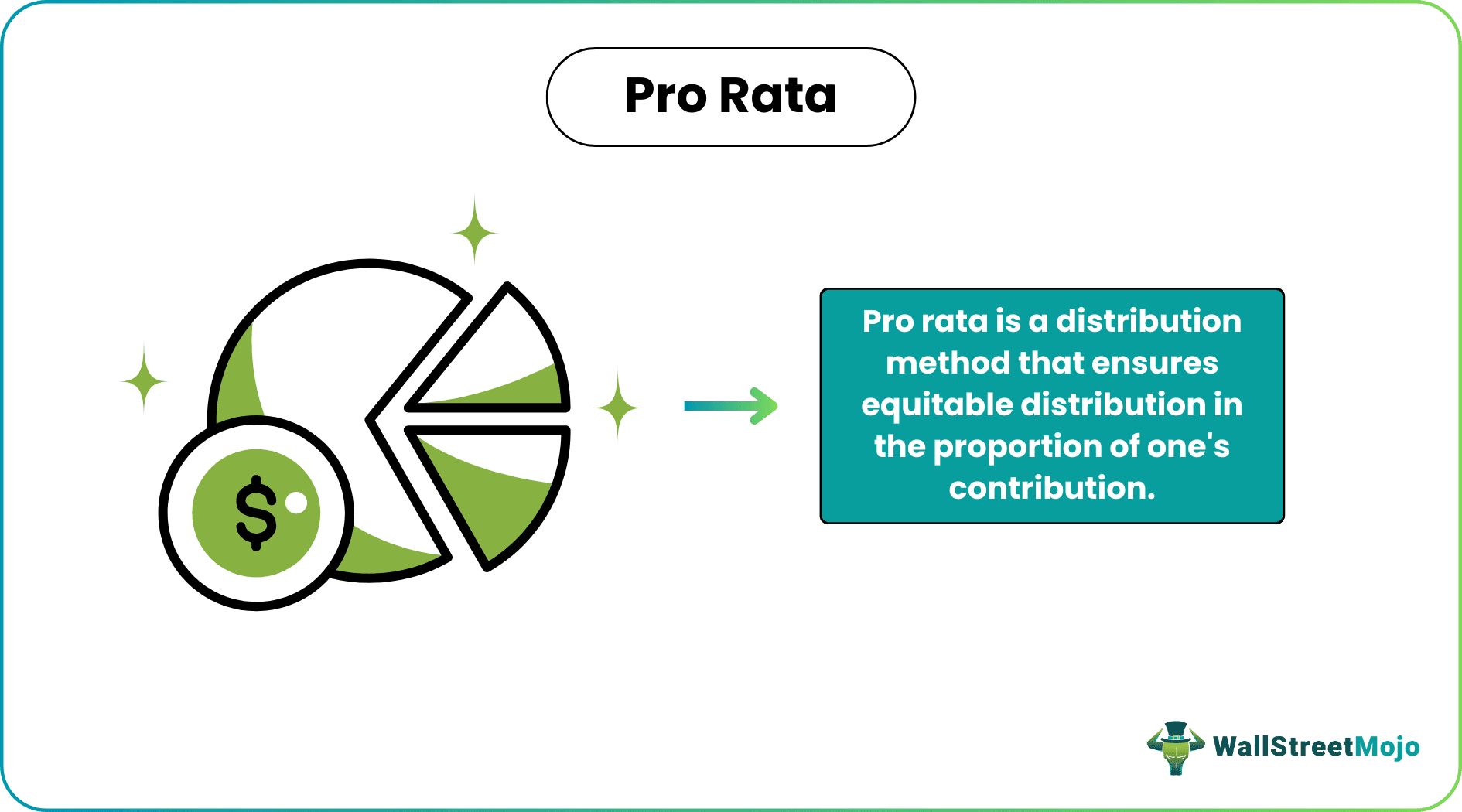Table Of Contents
Pro Rata Meaning
"Pro rata" refers to a fair and equitable method of distributing something. The term is derived from Latin, and it means "in proportion" or "proportionally." Using this method, each party receives a share proportional to their contribution or entitlement, ensuring fairness in the distribution process.

The pro rata method is commonly used to calculate the appropriate reimbursement amount for each party based on their proportionate participation in a given business. This method is especially useful for calculating gains and payments for short-term or partial periods. In addition, it can be applied in various scenarios where proportionate distribution is necessary, including computing hourly wages, expenses, investment profits, and other liabilities.
Key Takeaways
- Pro rata is the term used to describe a fair allocation of resources. For example, money is distributed according to each person's appropriate contribution.
- It is an exceptionally useful concept when the exact value of anything is difficult to determine but can be easily articulated about other related items.
- It makes calculating gains and payments for short-term or partial periods simple.
- The formula for calculating pro rata payment: Prorated amount = fractional ownership * total asset to be allocated
How Does Pro Rata Work?
Pro rata is a term used to describe a fair allocation of resources, where money is distributed according to each person's appropriate contribution to the total. This method ensures that the distribution of income, expenses, assets, liabilities, and other components among the participants is proportionate, whether they are companies or individuals. In addition, it allows everyone to receive their fair share of a particular asset, such as compensation, dividends, or a company's earnings.
Pro rata is an exceptionally useful concept when the exact value of anything is difficult to determine but can be easily articulated about other related items. For example, it is commonly used to calculate part-time salaries. In addition, having flexible workers available is helpful when a team member is absent or unable to work. Employers can contact them to step in for the day and pay them proportionately for the work they have completed rather than the full salary.
Pro rata calculation helps determine the amount to be paid in proportion to the work done. This method can also estimate the interest earned on an annual investment over a shorter period and calculate pro-rata holiday or annual leave for part-time employees. The pro rata basis refers to the idea that part-time employees' vacation days will match their weekly work schedule. Other uses of pro rata include developing budgets that involve various departments and demands and distributing expenditure.
How To Calculate?
To calculate a pro rata value, one must divide the total amount to be distributed by the percentage each individual or company is entitled to receive. The formula for calculating a pro-rata payment is as follows:
Prorated amount = fractional ownership * total asset to be allocated
Here are the steps involved in the calculation:
- Gather the necessary data.
- Calculate the pro rata share. The share is derived by dividing the number of available values of an item by the total or maximum value of the item.
- Calculate the pro rata distribution.
Examples
Example #1
Suppose GlobEX is an American corporation that intends to distribute $250,000 in dividends to its shareholders. The total number of shares distributed is 10,000. Each share has the same dividend rate. To find out the amount of dividend to be distributed, the company does the following:
It divides $250,000 by 10,000 to get $25. There are 100 shareholders, and each of the 100 shareholders will receive $25 per share. Suppose one shareholder has ten shares; the dividend received will be 25 * 10 = $250.
Example #2
Sam, Dan, and Ben are partners in a limited liability partnership firm. They have invested the initial capital in 60%, 30%, and 10%, respectively. The three have agreed to share profits in the same ratio as their initial contributions. At the end of the year, They make a profit of $ 500,000. The respective shares of each partner will be calculated as follows:
Sam = $500,000 *60/100= $300,000
Dan = $500,000 *30/100= $150,000
Ben = $500,000 *10/100= $50,000
Pari Passu vs Pro Rata vs Per Stirpes
Let us compare pari passu, pro rata, and per stripes in the following table -
| Key Differences | Pari Passu | Pro Rata | Per Stirpes |
|---|---|---|---|
| Meaning | Pari passu is a clause in financial contracts that ensures equal asset distribution. | It is a distribution method determining how much of an asset or liability will be distributed. In other words, the distribution is made in proportion. | Per stirpes is a method of distribution that determines who receives a share of the inheritance. |
| Treatment | Pari passu gives equal treatment to all parties involved. | It treats involved parties in proportion to their contributions. | Per stirpes, treats the beneficiaries by the system in place. |
| Example | Pari passu is used in bankruptcy proceedings to ensure equal distribution of assets. | It is used to calculate the payment for short-term or partial periods. | Per stirpes is used to distribute inheritance among a deceased beneficiary's descendants. |
